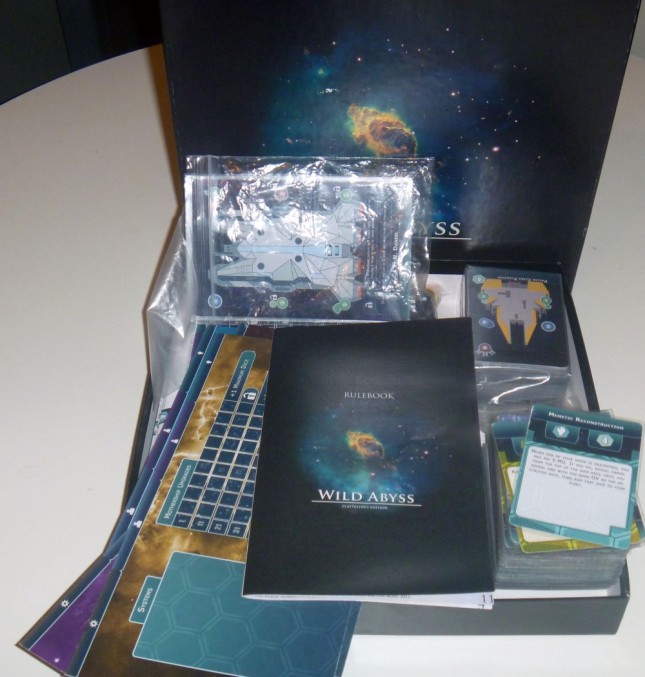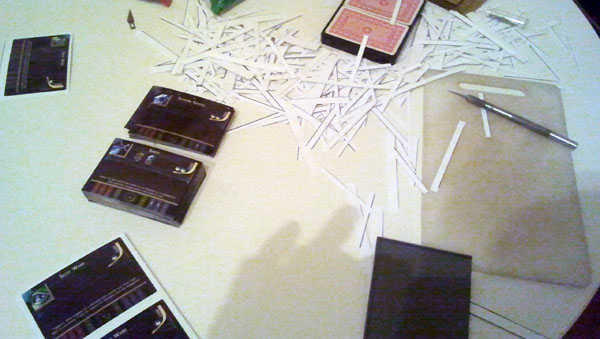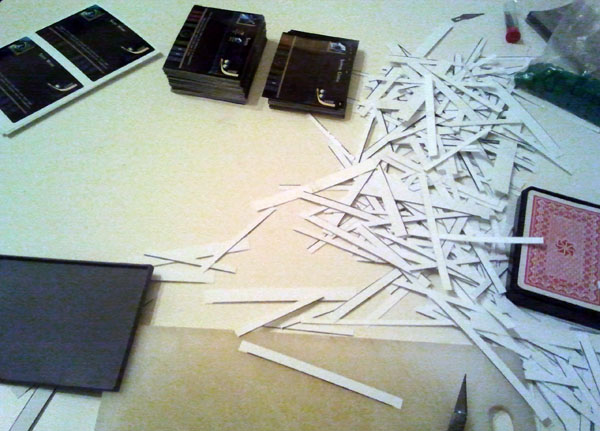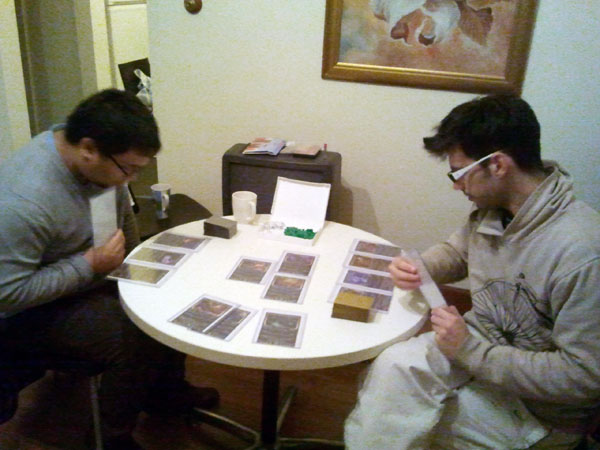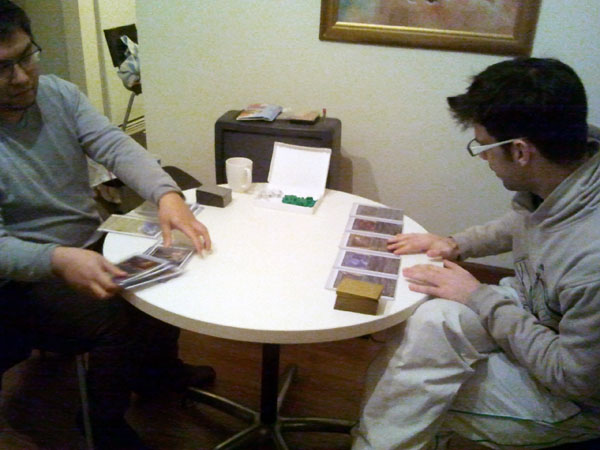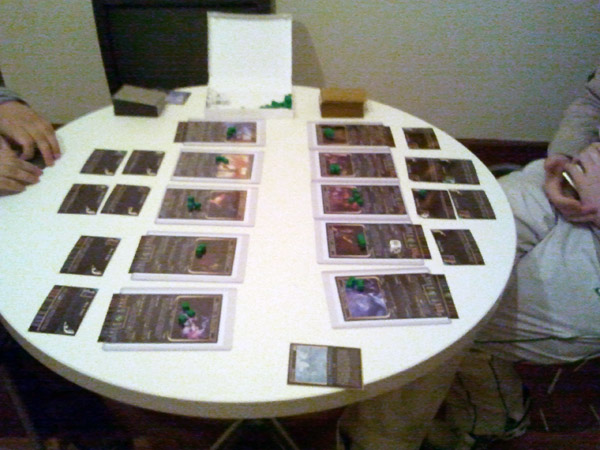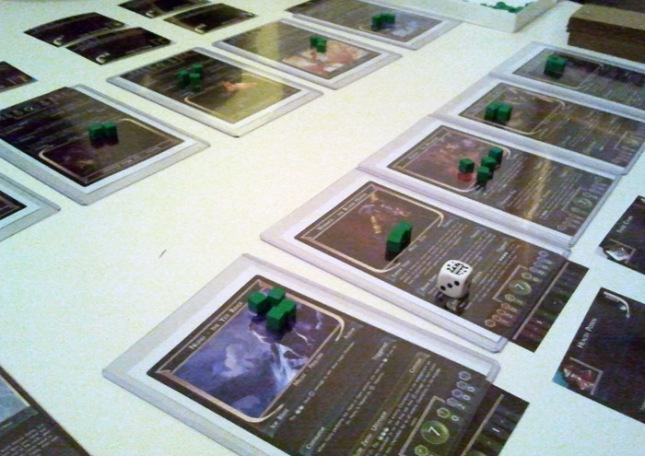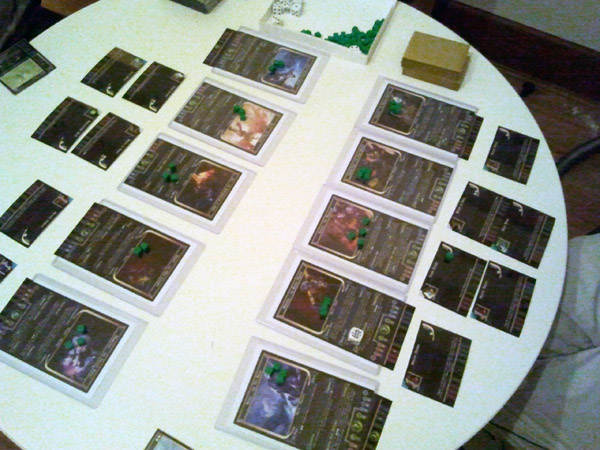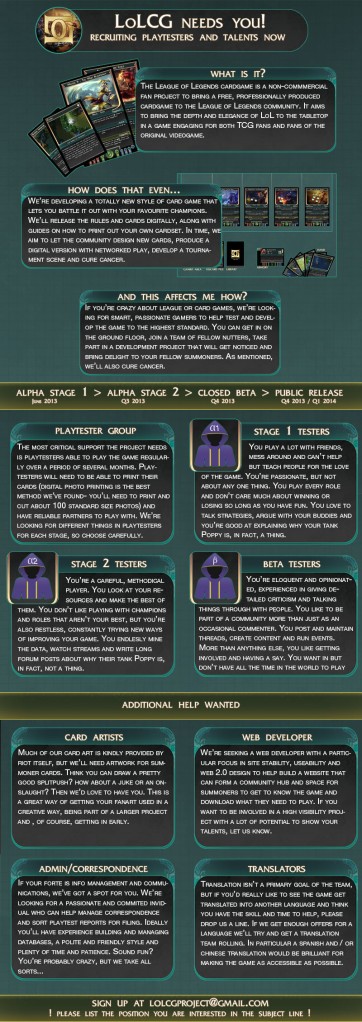“The soul of a game is its players.”
This is kind of a mantra for me, something I repeat a lot when I get caught up in the technicalities and artisinal aspects of game design. Understanding players and in so doing figuring out how one can provide what they need through your design is an incredibly important part of growing as a designer. Doing that is what this article is all about! It’s a pretty complex topic and it can’t be done quickly. Nevertheless, I’ve summarized as best I can in a TLDR that, in itself, is probably TLDR. I should note that I am a pretty ecumenical designer and so this article is written in broad terms so it can be applied to videogames, tabletop games, board games, social spaces etc. This means it’s sometimes a little vague in terms of direct examples, but I hope that the shell argument is clear enough that you’ll be able to apply the profiles provided to your particular area of interest
___________________________________________________________________________________
This is an article extending and developing Mark Rosewater’s Timmy-Johnny-Spike analogy of player psychographics. In it I re-evaluate and add to Mark’s archetypes under a more general context, and add two more families of psychographic archetypes based on the work of Richard Bartle and Roger Caillois. The result are the following families of archetypes:
The Rosewaters, who are characterized by what they find meaningful in their own actions during play. The Rosewaters are Mark’s original three psychographic profiles.
- Timmy: who finds the theater and narrative established during play meaningful.
- Johnny: who finds the opportunity to express his individuality and creativity through play meaningful
- Spike: who finds the opportunity to overcome legitimate challenges in play meaningful
The Cavottas, who are characterized by what they find meaningful in what can be taken from the game-artifact. The Cavottas are an extension to the original MTG psychographic profiles. Vorthos was originally suggested by Matt Cavotta, Melvin by Mark Rosewater, Richie by myself.
- Vorthos: who finds the diegetic environment set up by the game meaningful
- Melvin: who finds the craftsmanship invested in the game meaningful
- Richie: who finds the context in which the game is situated meaningful
The Bartles, who are characterized by what they seek to accomplish through their play, external to the objectives of the game itself. Each Bartle is based on one of the four suits in Bartle’s suits analogy.
- Ace: seeks to build concrete markers of achievement and progress for both in order to track and order her progress and for the status and recognition those achievements may convey. Ace is based on Bartle’s ‘diamond’ player-type
- Jack: seeks to discover, learn and understand more in order to further his knowledge both of the game itself and of the world more broadly. Jack is based on Bartle’s ‘spade’ player-type
- Daria: seeks to observe other people and use those observations to build relationships with them, using the game as a vessel to encourage this. Daria is based on Bartle’s ‘heart’ player-type
- Ryan: seeks to advance his social standing and use games as a vessel for determining his position in the heirarchy of his peers. Ryan is based on Bartle’s ‘club’ player-type
The Caillous, who are characterized by the state they most desire to achieve through playing a game. The Caillous are based on Caillois’ analysis of game types and why the experience provided by each is meaningful.
- Calomel: wishes to achieve a state of decreased import, where his decisions are of no real consequence. Calomel is based on Caillois’ Alea(chance) game-type.
- Petra: wishes to achieve a state of order, where the environment conforms to known laws. Petra is based on Caillois’ Agon(contest) game-type.
- Mica: wishes to achieve a state of true loss of self, where he is entirely absorbed by the experience of sensation or altered perception. Mica is based on Caillois’ Ilinx(vertigo) game-type
- Opal: wishes to achieve a transportment of the self, where she inhabits the identity of another. Opal is based on Caillois’ Mimicry game-type
These archetypes are intended to provide a more holistic set of psychographic tendencies in game-players, expanding on the card game/system design focused Timmy, Johnny and Spike. While TJS align closely with the natural interests of game designers, accounting and designing for these other profiles may give designers a larger spectrum of perspectives from which to evaluate their work. In the article proper, I more thoroughly explore the motivations and typical behaviours of each archetype, sticking to the spirit of Mark’s original analogy in presenting each as a character.
It’s worth noting, as Mark did, that in reality these analogy-characters are more subtle tendencies in players, who are likely to identify with many, if not all of them depending on the specific game or context they are in. With fourteen profiles rather than three, it would be impossible to explore every combination to demonstrate this as Mark did. Once I’ve recuperated from this wall of text, I might go into considerations more. In the meantime, dear reader, it’s important not to get trapped into the idea that you are ‘a Timmy’ or ‘a Ryan’- these profiles are hyperbolic representations of desires and tendencies that are all present in everyone and come out to play, as it were, depending on perspective and context. For designers, understanding what properties engage which desires and behaviours is important. For players, it can simply be interesting to understand the many and diverse motivations that bring people to the table and as such have a greater appreciation for how other players may see the same games differently.
___________________________________________________________________________________
THE ROSEWATERS
Let’s begin with the classics. If you’re already familiar with these guys, don’t skip ahead! I’m going to look at them in a slightly different light here. Mark’s original analysis was to type these players by their motivations- desire to have fun (Timmy), desire for recognition (Johnny) and desire to prove oneself (Spike). Unfortunately, these profiles are quite vague and even in the in-depth followup Mark wrote, there are lots of subcategories and profiles within each archetype that fog things up. Timmy in particular ‘plays to have fun’, which even when looked at in-depth is a little trite- Everyone plays to have fun, we just all get our fun in different ways. This particular case led me to try and clarify what makes each of Mark’s players truly unique and in doing so spawned this epic voyage through the psychology of play. I’ve contextualised these profiles in terms of how they relate to winning, but I’m not sure that’s the most accurate way of expressing it, especially given the various ways in which a player can be considered to ‘win’ a game.
___________________________________________________________________________________
Timmy:
Timmy plays games because they provide spectacle and theater. He appreciates mechanics that create dramatic tension, moments of wonder and cinematic hyperbole. You’ll find Timmy playing games that allow him to make grand gestures and express dramatic points. When the end is certain, or even sometimes just likely, he is inclined to make plays that have no effect on the game but he feels are symbolically important. Timmy loves to tell stories about the time he carried his team, landed a one in a million headshot or top-decked the right card at the perfect moment. For Timmy, games allow him to inhabit larger than life stories and be a part of the action. Winning the game is only meaningful to Timmy if the victory fulfills his expectations based on the ‘plot’ the game has developed.
____________________________
Timmy’s traits:
Timmy is typically outgoing and enthusiastic- he gets caught up in the action and can’t help but share what he’s feeling. Since the subtle narratives that games tell when a player has a deep understanding of them are often very attractive to Timmy and these take a while to come to appreciate a game fully, he will often have difficulty approaching new games, but have a deep passion for those he has invested a lot of time into. He gets frustrated when games are predictable or become about calculating minutiae rather than advancing the plot. At his best, Timmy makes playing with him deeply enjoyable by sharing his vision of the narrative with charisma and flair, helping awaken the Timmy in everyone else. At his worst Timmy begrudges things which don’t fit his vision for the game and becomes sullen if a game or opponent denies him his symbolic statements and victories.
____________________________
Designing for Timmy:
To design for Timmy a designer needs to have an understanding of narrative theory and an appreciation for the tropes of both their game’s genre and their aesthetic’s genre (science fiction, horror etc). Games which reliably create tension and cinematic moments will be immediately attractive to Timmy, but only games which have a deeper, more interactive narrative will hold his attention for long, so a game ideally suited to Timmy must be both superficially spectacular and dramatic to get his attention but also create deeper, richer narratives through its mechanics to keep him digging deeper and grow his love for the infinite stories the game can tell.
___________________________________________________________________________________
Johnny:
Johnny plays games because they allow him to express his creativity. He appreciates mechanics that allow for many permutations and subtleties, edge cases and unique interactions. He likes being able to have the opportunity to gather information and use it to make creative choices. Where Timmy likes to let the game create its own story, Johnny wants to make the game tell his. Johnny likes to do things the hard way, putting limits on himself to force the creative juices to flow. Ironically, he often spends a lot of time looking at what everyone else is doing just so he doesn’t end up inadvertently doing the same. Johnny often takes pride in having a ‘style’ that he sticks to, regardless of the obvious choices to be made. Winning the game is only meaningful to Johnny if it was a result of a choice he made based on his own initiative.
____________________________
Johnny’s traits:
Johnny is typically studious and knowledgeable, eeking out every bit of information about a game he can get his hands on. While he wants to make his own mark on the game, he’s not necessarily egotistical- he eats up the exploits of others and uses their cleverness to fuel his own creativity. As such, Johnny tends to create extremely strong and deep communities and friendships with other like minded players. At his best, Johnny is respectful of the efforts of others to forge their own space and enjoys sharing his own knowledge to help others deepen and personalise their own play. At his worst, Johnny is stubborn and spiteful, trying to force individuality from a game in ways that don’t add to the experience and making bad choices just for the sake of being different.
____________________________
Designing for Johnny:
To appeal to Johnny a game needs to have clear areas in which he can personalize his play. Even superficial elements like character customization can succeed at holding his interest for a while, but ultimately a game needs to provide many permutations and routes which lead to meaningful destinations. For Johnny, it’s not enough to be able to go right or left at a junction where both paths ultimately lead to the same ending. Anything that breaks the illusion of agency (portal 2) is damaging to his experience. For single player games it can be enough to provide enough legitimate options for him to personalize his journey, but for multiplayer it’s important that a game does not just provide an outlet for mechanical and technical skills but for both strategic and tactical creativity. It’s important to recognize that Johnny is a very social player- he shares his experiences. If he finds that his experiences are too similar to everyone else’s he will become disillusioned with the play. If his community consistently provides new discoveries, ideas and perspectives, the game at its heart will retain his loyalty.
___________________________________________________________________________________
Spike:
Spike plays games because they allow him to test himself. Spike doesn’t care a lot about individual mechanics, he cares about how they come together- if they create a game where he is legitimately tested and has to earn his progress, whether it be through determination, creativity or skill, he will enjoy the experience. Spike plays to achieve the peerless sensation of triumph that comes from diving into an uncertain situation and through every trick in the book making it come out alright. When the end is certain, Spike feels no compunction to keep playing- he is only engaged while everything is still on the line. Winning the game is only meaningful to Spike if he had to work for it.
____________________________
Spike’s traits:
Spike is typically calm and determined, unfazed by most losses and ready to dive straight back into another game after only brief reflection. While, like Johnny and Timmy, he plays to win, often he sees individual victories as far less meaningful compared to a larger trend. As a result, Spike can seem intimidating or impassive, where in reality he is fiercely calculating what he could have done differently and preparing for the next bout. At his best Spike is an asset to the community, willing to invest his time into helping other players up their game so they can give him a real fight, pulling the level of play ever upwards with him. To paraphrase Ben Stark, Spike doesn’t want to play against people who don’t make the best decisions possible- thus providing a genuine test of his abilities. At his worst, Spike can devolve into a win at all costs psychology, spending their time crushing players below their level and avoiding fair fights to prove to himself he can compete.
____________________________
Designing for Spike:
On the surface, designing for Spike is a relatively simple affair. It’s necessary to make sure the game can challenge a player who is growing in skill constantly and that the skill of a player has a serious impact on their success- truly random outcomes or clear advantages for a player not balanced by taking turns or similar will quickly turn Spike against a game. The more of these elements a game contains, the shorter each instance needs to be so Spike can play, reflect and dive back in repeatedly, deriving his accomplishments from a sample of many games played rather than single instances. It’s also important the game has obvious methods by which a player can measure their development- time spent, score, ranking, hitpoints and so on all give a player yardsticks to see their progress. It’s important to recognize that these yardsticks are not specifically to allow Spike to measure himself against other players, but to measure where he was against where he is. For Spike, putting in the work and getting results is what is meaningful, not beating others. There are many ‘Spikes’ for whom this is also an important psychological factor, but it is not a property of their ‘Spikeness’- it’s a property of their ‘Ryan-ness’, which will be explored below.
___________________________________________________________________________________
THE CAVOTTAS
Where TJS are focused around areas of the game in which the player’s direct interactions and the resulting outcomes are essential, the Cavottas instead take a more hands off approach. Their appreciation is rooted in the game as a piece of craftsmanship or authorship, as it exists without their specific interaction. That is not to say they do not enjoy participating in and acting on the game, but this is not the primary reason they engage with it. I’ve made some significant alterations to Mark and Matt’s original vision here, since I think there is a huge difference between deep involvement in fiction and involvement in craft or culture.
___________________________________________________________________________________
Vorthos:
Vorthos plays games to engage in Diegesis. Diegesis is a term that encompasses becoming swept up and involved in a fiction. Sometimes this is a designed fiction (the official lore) sometimes it’s Vorthos’ own fiction- constructed around the ‘official’ version. Like all the types in his subfamily, Vorthos’s interests are largely independent of the play of the game itself. Instead, he is interested in the aesthetics of the game on their own. He takes his time to stop and appreciate the scenery, even at the cost of efficient play. He roleplays characters or imagines himself in their position, becoming emotionally involved with the fiction. Where Timmy is interested in the narratives that he creates through his own play, Vorthos is interested in experiencing and exploring those that already exist within the game to their fullest. His own interactions with the game act primarily as a ritual to get him into the right frame of mind to immerse himself in ways that non-interactive media like film and books cannot achieve. At the deepest level of immersion he might experience events during a game from the perspective of a character within the fiction. Vorthos finds games that provide a compelling and thoughtful aesthetic meaningful.
____________________________
Vorthos’ traits:
Vorthos is typically attentive and involved, becoming deeply immersed in both the actual play of the game and exploring the aesthetics and narratives designed into it from the outside. Like Timmy, Vorthos looks for the story in a game, but in a more impersonal fashion. He’s quite happy to play a weaker element and lose to stronger ones because that makes sense. Like all members of his subfamily, for Vorthos winning isn’t the point. Often Vorthos creatively finds ways of developing the atmosphere of a game, whether it’s by gathering accessories that set the mood or by adding his own take on unexplored elements of the fiction. At his best Vorthos contributes to the atmosphere of the game through characterful play and sheer intensity. At his worst, Vorthos becomes a vocal nitpicker- loudly complaining about anything which damages his sense of immersion.
____________________________
Designing for Vorthos:
The most crucial element in designing for Vothos is internal consistency- ensuring the story the game creates does not contradict itself or bring up absurd situations (unless, of course, that is the entire point of the game). These are the things that shatter Vorthos’ immersion and reduce the integrity of the game for him. Most Vorthos’ are capable of a reasonable level of suspension of disbelief and are willing to tolerate some allowances for the sake of gameplay, but sloppy, derivative world building or tacked on elements will kill his interest very quickly. To attract a Vorthos to a game, there need to be strong aesthetic hooks which he can latch onto and pull himself into the story with- companion literature, biographies of key characters, lore available online or on the game’s box and so forth. ‘Getting in the mood’ is very important to him: encouraging and enabling a ritualistic descent into the space of play will help Vorthos find his place greatly.
___________________________________________________________________________________
Melvin:
Melvin plays games to understand how they work. For Melvin, everything can be broken down into smaller and smaller bits and then rebuilt to do interesting things. Melvin spends his time tinkering with programs or old cars- experimenting with changing rules, modding and so on. Through these activities, Melvin comes to appreciate how things fit together and what makes the gears spin and the wheels turn. The reward for Melvin is in often more in watching the machine in action than using it for its intended purpose, because to him the process itself is a thing of beauty far beyond whatever rewards success might yield. That’s not to say Melvin is entirely uninterested in the outcomes, but it’s more about testing his understanding of the mechanisms of the game than the victory-centric motivations of Timmy, Johnny and Spike. Melvin finds games that produce intricate, elegant interactions and actions meaningful.
____________________________
Melvin’s traits:
Melvin is typically curious and careful, making sure understands everything properly. He’ll often propose hypothetical scenarios to see if he’s reading the game the same way as other players and be the one to write into the designers for clarification if not. While Melvin can sometimes be a terror for designers he can often be their best friend as well, both by making sure everything is seamless and by expressing his delight when it is. Melvin is likely to be more ecumenical in his choice of games than most, since pulling apart many games can give him insights into common trends that run through them all and consequently appreciate novel takes and creative uses in designs. However, it is distinctly possible for Melvin to become exclusively attached to a very complex or large game as he sorts through the many subtle permutations it creates. At his best Melvin can be incredibly insightful and develop the way a game is played in new and unexpected ways. At his worst, he can lose sight of the intent of the game entirely and try and force it to act like other things he likes, working against rather than with the existing mechanisms.
____________________________
Designing for Melvin:
The most important consideration for designing for Melvin is to leave the mechanics visible. For analogue games you can’t help but do this, but often videogame designers are inclined to hide the numbers and interactions away in a black box. For turbo-Melvin this is no obstacle, as he rips apart the game’s code to dig into the raw, seething numbers inside, but a less technically adept Melvin the inability to get at the man behind the curtain can be frustrating. This isn’t to say that analogue game designers can’t do anything to court Melvin, though. Mechanics which build on or subvert mechanics from other, similar games can attract Melvin’s interest, designer blogs or articles on why choices were made likewise. Melvin spends a lot of his time appreciating a game outside of actually playing it, so it’s there that considerations can be made for him.
___________________________________________________________________________________
Richie:
Richie plays games to engage with culture. For Richie, a game isn’t just something to be taken on its own- games exist as part of a cultural fabric, interlinked with each other. Richie is in the truest sense the ‘meta-gamer’, who plays games to see how they relate to each other and discover the story they tell as a collective whole. Richie is attracted to games with cultural weight- award winners, genre definers and long histories. He enjoys being a part of this larger whole. His stories are full of anecdotes about how he met a famous player or how he has an original copy of this or that game. To Richie, context is everything. Richie finds games which allow him to experience connection to a larger culture meaningful.
____________________________
Richie’s traits:
Richie is typically independent and detached, though at times he can become incredibly passionate and involved if he feels a situation is important enough. Like Melvin, he’s likely to play a lot of different games, though he selects them for their cultural relevance rather than their mechanical properties. Richie is inclined to be a collector of cultural artifacts like misprinted cards or limited edition memorabilia. He’s likely to inhabit communities directly linked to a game’s author or (for older games) governing body and to take part in official events. He might try and re-create famous games or events or organize meetups to watch historic tournaments. At his best Richie makes the game a more profound experience by broadening the perspective of his fellow players and allowing them to experience the game in the larger context he sees. At his worst, Richie can (and will) constantly identify shortcomings of a game compared to other games or self-importantly fixate on a single game as ‘the most important’, trying constantly to reinforce that perspective and looking down on all others.
____________________________
Designing for Richie:
Designing for Richie can be as simple or complex as you like. Simple things that attract him are genuinely unique collectibles or other articles associated with the game that have historical weight. These encourage him to buy into the game and give him the motivation to invest further time and effort into getting to know it. Unfortunately, these won’t be enough to keep the attention of a serious Richie. Hosting events, openly discussing the legacy of design on which the game is based, giving the developers the chance to build their image and hold conversations with the public, these give Richie a more subtle but enduring way of placing the game in context and finding their place within that context.
___________________________________________________________________________________
THE BARTLES
In a sense, the Bartles are the original player psychographics- at least, I haven’t been able to find an earlier attempt to specifically categorize the motivations of players. Compared to the Rosewaters and Cavottas, the Bartles are more broadly focused, based around what they get out of playing games. Perhaps as a legacy of arising from a massively multiplayer game which attracted certain types of players, the Bartles are typically framed around their social perspectives and interests. Richard’s article was, after all, titled ‘Players who suit MUDs‘.
___________________________________________________________________________________
Ace:
Ace wants to gather material markers of progress and prestige through playing games. For her, satisfaction is largely derived from what remains after the game is played- a notch on the scoreboard, some achievements, an acknowledgment of skill from a fellow player. Unlike Spike’s internal focus, Ace cares deeply about how she is perceived and will often go out of her way to play in a way that is likely to be noticed by her community. Ace is often an avid collector and enjoys structured experiences with goals that can be seen long before they are accomplished. She likes setting out to accomplish something and the feeling of satisfaction she gets when she gets it done.
____________________________
Ace’s traits:
Ace is an externally focused personality, it’s important to her not just how she sees her achievements, but that she can demonstrate them and use them for social leverage. As such, she’s likely to place a high value on symbolic objects- trophies, collectibles and other markers of her position. While Richie tends to collect things to position himself in relation to a larger phenomenon, Ace collects things to add to her own identity, so she places a particular value on unique markers of achievement such as trophies. Where a formal marker is not available, Ace may create her own system of goals and mark them with whatever is at hand- setting out to collect a certain set of items or noting down games in a notebook that she can use to track her play. At her best, Ace is pragmatic and dedicated, motivating other players to become more involved in the games she plays by providing a highly visible example of what can be accomplished, at her worst Ace can poison the climate of the game for other players by demanding they conform to structure and play according to plan, which for many player personalities is neither relaxing nor particularly engaging.
____________________________
Designing for Ace:
Modern videogame design has been heavily influenced by Ace’s presence in the market. The compartmentalized, structured nature of most traditional videogames ideally suit Ace by providing a clear structure of progression. The advent first of scoreboards and then of achievements granted her tangible, persistent markers that are difficult to come across in analogue games outside of competitive communities that award participation or success in competition. Ace is the sort of person who wants to get her black-belt because it means she has a black-belt- a marker that anyone can recognize. If a game provides opportunities for this kind of notoriety, it’s likely to grow on Ace and involve her over time. It’s important to recognize that while Ace is driven by the desire for formal achievement, an internal sense of progress and accomplishment is important to her enjoyment. Thus she tends to find games that provide a structured, long-term sense of progress attractive over throwaway experiences- for example, a game with a set of pre-compiled scenarios may attract her more than one with randomly generated ones since she can methodically play her way through them from a ‘start’ to a ‘finish’ rather than having to set her own artificial goals.
___________________________________________________________________________________
Jack:
Jack wants to discover and learn through playing games. For him, games provide an endless supply of novel experiences he can use to uncover interesting facts and ideas. Unlike Melvin, he’s not so much focused on investigating the game’s inner workings as a piece of craftsmanship, but more on the opportunities for investigation the environment of the game throws up. Best of all are discoveries that can be applied outside of the game itself, rewards for using the system to learn and grow. Jack sometimes enjoys wandering and following his nose, sometimes methodically covering an area of investigation and then applying the results.
____________________________
Jack’s Traits
Jack is the most internally focused Bartle: it’s most important to him that he learn and discover, regardless of what other people think. All that matters is that he feels he’s learning something new. Ask him what he finds cool about a game and he’ll open up and bombard you with trivia about how it relates to other games or even just other challenges, whether he feels the game is ‘relevant’ or not. Jack is amongst the most likely personalities to get obsessed with a complex, intricate game system since the more he plays the more he comes to appreciate the discoveries in the system. Unlike the more externally focused personalities, he doesn’t feel a huge pressure to share his discoveries, unless it is to confirm them, so his involvement in player communities is likely to be in the form of speculative commentary (‘I wonder if this is related to that’, for example) or checking to see if his discoveries are valid (‘has anyone else noticed that X is a thing?’). At his best Jack is an incredible asset to the player community, communicating how the game is connected other media, real life challenges and problems. At his worst, Jack becomes fixated and isolated, participating in community play only if necessary and ignoring the intended goals of the game in a way that frustrates or annoys other players.
____________________________
Designing for Jack:
Designing for Jack on a basic level is elementary, simply requiring that the game throw up interesting situations and having a level of complexity that allows for prediction and investigation- the sort of qualities that game designers almost always seek in the first place. On a higher level, however, providing connections to outside fields of learning or problems with subtle notes- references to real world sources or call-outs to well known problems can help Jack latch on and find significance in his investigations. Sid Meier’s games are an excellent example of games with elements heavily suited to Jack’s interests from the technology placards in Civilization to the philosophical musings of leaders in Alpha Centauri.
___________________________________________________________________________________
Daria
Daria wants to share time and develop bonds with people through games. For her, games are a way of breaking down social boundaries and getting people relaxed into a good time. She loves the intimate cooperation or friendly, no pressure competition the games create and consequently how they expose the best (and sometimes the worst) of people she’s interested in. Sometimes Daria is more interested in observing people and figuring them out, sometimes she’s more interested in making sure they have fun, but whatever the case, her attention is on the people she plays with as much as the game itself.
____________________________
Daria’s traits:
Daria is an internally focused personality, an odd notion for someone who appears strongly attached to playing with others. For Daria though, unlike Ace and Ryan, it’s what she gets from others that’s important to her, not the other way around. Daria loves company and finds being around others a relaxing and pleasant game in and of itself, with formal games serving to enhance the intimacy and intensity of the contact. Daria loves to play co-operative games or work on puzzles, especially if she finds competitive games cause other players to hold a poker-face or maintain a certain distance from her. That said, when competition can be had in an open and friendly environment, she’ll often be amongst the most enthusiastic players. Daria has a tendency to be one of the most polarized players in terms of what games she likes and dislikes, finding single-player or complex, intricate games that require intense focus on the system completely un-engaging while loving games that provide rich social interaction and memorable experiences.
____________________________
Designing for Daria:
Designing for Daria is of particular concern for game designers creating games that follow the traditional videogame model of a single player story and competitive multiplayer, neither of which modes fundamentally appeal to Daria, especially given the tendency to limit communication and social interaction between players in multiplayer videogames in order to curb abuse. Being able to directly observe other players is important to her, so her enjoyment of games is somewhat threatened by the increasing dependence on anonymous online play in some areas of the games industry, leading to a polarization between Daria communities of ‘social gamers’ and game-focused communities of ‘hardcore games’. Given the spur of this discussion was MTG, I think it’s an excellent example of game that manages suit Daria while being highly competitive at its core. While the analogue game is most suited, MTGO has developed a surprisingly social turn thanks to developments in streaming and sub-metas based around non-traditional formats like Commander or Momir Basic. It’s this more personal, localized kind of community that Daria thrives in and if a game provides the capability for players to build smaller, more focused social networks, she’ll likely find a group in which she can make connections and build relationships that make playing the game more worthwhile to her.
___________________________________________________________________________________
Ryan:
Ryan wants to show he’s the best through playing games. For him games are a controlled environment in which he can demonstrate he’s on top of the heap. The specific reason varies, sometimes it’s a part of his sense of self-worth, sometimes it’s peer pressure that demands competitive success. Whatever the reason, it’s important to Ryan not only that he’s a winner, but that people know he’s a winner. Ryan enjoys pushing games to the limit, beating challenges others have set him and building his reputation. Unlike Spike, however, he also enjoys thoroughly beating people at a lower level because it will demonstrate his capabilities and reinforce his social position.
____________________________
Ryan’s traits:
Ryan is the most externally focused Bartle- his sense of accomplishment is based on his relative position to others. Unlike Ace, for whom the badge for 100 hours played is just as meaningful to her if all her friends have it, for Ryan it’s important that he got it first. Ryan is the archetypical hyper-competitor, eager to fight and win. Yet, since winning is the point, if not held to account he’ll tend towards playing easier opponents and challenges rather than going for a ‘fair’ fight, especially if he’s having trouble. You could think of it as an inbuilt match-making system that will try and balance things at about a 75% win rate- enough that Ryan feels he’s on top of his game, but not enough that his victories are trivialized. At his best, Ryan is a passionate and honorable competitor who embraces legitimate challenges is motivated to persevere by failure. At his worst, Ryan will become the archetypical ganker or smurf-player, seeming to play only to ruin the experience of others.
____________________________
Designing for Ryan:
Designing for Ryan is actually a well established part of modern game design, since Ryan tends to be the guy everyone else gets annoyed at for exploitative tactics, subtle cheating and other ‘unsportsmanlike’ behavior. Of course, Ryan isn’t compulsively attracted to these tendencies, but he is more likely to engage in them if he’s having trouble and they’re a possibility. Preventing the opportunity for such behavior is of clear importance to ensuring Ryan plays fair. It’s important to note that Ryan is a very externally focused personality, he cares how other people perceive him. Developing strong cultural stigmas in the game attached to picking on easy targets can push Ryan towards competing with his peers rather than dominating lower level players, if the latter activity will genuinely discredit him (and not just a throwaway identity created for that purpose). Running limited size leagues that reset regularly may keep him engaged by giving him the opportunity to show he’s on top with less incentive to go all out and engage in unhealthy behavior to get there as a persistent, universal league might.
___________________________________________________________________________________
THE CAILLOUS
Unlike the others profiles, the Caillous are more indirectly created, rather than adjustments or refinements of existing profiles. Caillois’s work was primarily in cultural and social analysis of games and rituals, rather than psychological analysis, but I’ve tried to derive the basic psychological arguments he was making as part of his categorization of games. The particular insight of Caillois was to note the kinds of experiences that people seek during play to distance themselves from their day-to-day state of life. You could call this the ‘transportment’ that games offer, and each of the Caillous seeks a different kind of transportment.
___________________________________________________________________________________
Calomel:
Calomel wants to relax and feel like there’s no consequences when he plays. For Calomel, games provide an opportunity to escape from the very real dangers and risks of daily life. In play, he can put things on the line, try for a one in a million and do many other things that he can’t justify risking outside of the game. Calomel tends to like games with a high degree of uncertainty or variance since they allow him cathartically indulge the desire to all-in. For Calomel, games are less impactful than the rest of his life.
____________________________
Calomel’s traits:
Calomel tends to be laid back and relaxed, not investing in victory or begruding a loss. He likes make risky or over-the-top plays, but isn’t particularly concerned if they fail- for him that’s what games are for, the experience is liberating. Unfortunately, Calomel is also the most likely to have difficulty with gambling or other game-like situations that have real-life implications, as he may make real losses if he slips into his desired, playful mindset. At his best Calomel is fun loving, enjoyable company who helps people into a playful mood, at his worst Calomel can end up taking too many risks for the sheer sake of it and disrupting the natural flow of a game, frustrating other players.
____________________________
Designing for Calomel:
Elements of chance and risk-taking in a game are crucial for Calomel, since his understanding of play is as a consequence-less microcosm of his life. Being able to take the risks he can never take in reality is cathartic for him- in fact, the very act of committing to something where he has a high chance of losing is something he’s likely to do under normal circumstances, so a friendly, competitive game that provides that chance is fundamentally appealing to him. Providing largely inconsequential opportunities to try his luck- like randomized rewards or guessing games to determine turn order help Calomel get in the mood to play. There’s an ethical aspect to designing for Calomel as well- it’s important for your game not to provide a gentle ramp of consequences to risk-taking as is so prevalent in the gambling sector. This is the sort of property that will hook Calomel in and have him taking risks he’s fundamentally opposed to without realizing it, leading to extremely problematic outcomes. Providing a sharp distinction between ‘no real consequence’ risk and ‘actual consequence’ risk in games whose purpose is to entertain Calomel is crucial to his ultimate enjoyment and healthy participation.
___________________________________________________________________________________
Petra:
Petra wants to feel like everything is ordered and comprehensible when she plays. For Petra, games provide a space where the rules are known and must be obeyed. In everyday life, the rules of society and laws of the reality are too complex to be fully grasped, so Petra must stumble along making guesses and struggle to understand how things work. In a game, the rules are established, known and absolute, giving her the opportunity to make clear and logical decisions and feel justified in the consequences those decisions create. For Petra, games are more ordered than the rest of her life.
____________________________
Petra’s traits:
Petra tends to be meticulous and formal, making sure she has everything understood and that everyone else understands how things work. If she finds ambiguity, she’ll want to clarify it and establish a clear ruling on how it should be resolved. While she can become very invested in a game she plays, she tends to be very respectful both in success and failure so long as she feels everything was conducted within the rules as she sees them- the correct outcome was reached. She’s likely to spend quite some time studying a game before actually playing it, reading guides, wikis or rulebooks to make sure she understands how things work. At her best Petra is magnanimous and knowledgeable, helping other players understand the intricacies of the game patiently. At her worst, she can be intolerant of errors or inconsistencies, arguing about and begrudging issues that other players find trivial.
____________________________
Designing for Petra:
It’s important a game maintain an internal consistency within its rules for Petra to be attracted to it, since this appeals to her sense of logic. Situations where things behave strangely due to wordings or odd code interactions can ruin her sense of structure within the game world. It’s not important that the game be realistic, per-se, just conform to the expectations it sets out- if a different outcome occurs each time something happens, that is just as clear a ‘rule’ to Petra as if the same thing happens. Unexpected or unintended interactions are frustrating to Petra, as this is partly what she plays games to avoid. Similarly as for Melvin, making sure the logic of the game is visible is important to engaging Petra. Unintuitive mechanics are fine so long as they are clearly explained so they’re not unexpected when they occur. Petra does not inherently enjoy discovering the rules of a game through playing it, she prefers to go in understanding how things work, so providing well designed tutorials and other educational resources for her will help her prepare for play.
___________________________________________________________________________________
Mica:
Mica wants to see the world completely differently when he plays. For Micah games provide a space in which he’s allowed to let go and experience freely, which means he tends to avoid games with too much structure or heavy focus on objectives over participation. Mica is particularly attracted to games with an intense sensory component and flowing play that leaves no time for pondering or rational thought. For Mica, games are a kind of meditation, wherein can be had a loss of self and total absorption in the moment. Games allow Mica to enter a different state of awareness than the rest of his life.
____________________________
Mica’s traits:
Mica tends to be spontaneous and intense, quickly able to focus and lose himself in an activity he finds engaging. He can tend to be a little impatient and dislike being interrupted and pulled out of the flow of things. He has a tendency to enjoy taking things to extremes, particularly more physical games, pushing himself beyond the point where normal thought can cope and forcing himself into a state momentary reaction. He enjoys games where this sensation can be had in a simpler form- reaction games like Tetris (in the later stages) or rhythm games like Rez. At his best Mica has a powerful but unspoken charisma that draws other people into the zone. At his worst, he is likely to be snappish and antisocial, engaging only in solitary activities where his flow is less likely to be disrupted.
____________________________
Designing for Mica:
Mica is perhaps the most difficult and potentially alien profile for the typical game designer, as he tends towards the playful and spontaneous over the methodical and rule-bound. In fact, Mica is rarely attracted to most of the games the rest of the profiles enjoy, instead seeking thrills and experiences for his play- skydiving, moshing, watching a big screen film. Many games do not aim to provide the same kind of experience these activities do, but this is not to say they cannot. An ideal game for Mica is simple but intense, requiring absolute awareness and focus, a property which is most commonly created by reflex mechanics.
___________________________________________________________________________________
Opal:
Opal wants to become someone else when she plays. For Opal, games provide a space where she can see things from a different perspective and experiment with acting based on that perspective, without being held accountable for the mental shift. Opal is the classic roleplayer, not just pretending to be another character but diving deep into their personality, becoming them in every possible way. For Opal, games provide a ritualised and accepted space where this activity can be performed. She can shed her everyday identity and experiment with others, whether that be a dictator, adventurer or toy pony. In so doing, she gains a measure of perspective and adds to her own identity in subtle ways. Games allow Opal to be a different person than she is in her everyday life.
____________________________
Opal’s Traits:
Opal tends to be creative and empathic, as her temporary inhabitation of others demands she both have the imagination and understanding to shift her perspective. She is likely to become attached to characters others may find inconsequential because their design has caught her imagination and she has internally fleshed them out as a part of her play. She is also likely to very strongly roleplay her part in a game, making moral or practical judgments that fly against the structural mechanics of the game because that is how she imagines her character would act. When this causes severe conflict with the gameplay, she can become disillusioned very quickly. At her best Opal is capable of shifting frames of reference with fluid grace, bringing a game to life for others by totally inhabiting a character while never losing sight of the overall play. At her worst, Opal can totally stymie a game by fixating on particular character or context and trying to force the game to revolve around that one small part.
____________________________
Designing for Opal:
Depending on the circumstance, Opal can find many things helpful to her play. Detailed lore and background premises, tangential commentary by characters that helps develop the precise nature of their perspective, vivid illustration of people and places she may wish to inhabit and so on. Naturally, Opal will be drawn to games with a very high level of thought and craftsmanship invested into these elements. Yet she can also be highly interested in games with a strong but vague aesthetic, if she has a pre-existing interest in that aesthetic. A simple, open premise can give her the creative freedom to dream up characters and contexts of her own to step into the shoes of. In both situations, however, it’s critical to convey why she would want to inhabit such a premise or character, what the experience has to offer her. Understanding and promoting the underlying themes and conceits of an aesthetic design is key to engaging Opal, providing important questions she can feel she may be able to come to terms with by inhabiting a character in the game.
___________________________________________________________________________________
Congratulations if you made it this far! As you’ve read you’ve probably identified with many of these profiles, which I again should note is what’s intended. You may also have noted that several of the profiles feel quite similar to each other- for me the two that stand out like that are Melvin and Jack. While this is the case, there are always subtle differences that illustrate the intricate perspectives people adopt towards games. Melvin is captivated by the specific artifact of the game while to Jack it’s only a tool with which he can deepen his overall understanding of the world. Where doing something clever but very specific to your game will attract Melvin, Jack will only be engaged if he can see how it connects to other things outside the game.
Of course, someone can be both Melvin and Jack, with one profile gaining primacy depending on their mood- if relaxed and wanting to forget about life for a bit, the Melvin tendencies might surge. If curious and captivated by a larger genre, Jack may take the lead. Both result in behaviours of superficially similar appearance, but what engages their interest is significantly different enough that it can have a meaningful impact on whether they get into the game. This is the major weakness in Mark’s original psychographics articles I wanted to address- He typed players primarily by their behaviour, rather than digging to get to the underlying motivations and desires.
The process of psychographic profiling one is an endless one, so it’s hard to criticize anyone for stopping where they did ( I’m quite sure Mark, Richard and co. Actually have far more sophisticated mental models that they simply haven’t had the time or inclination to put to print). This is where I reach my limit for the time being- so feel free to dig deeper or dissect further. It’s an intriguing and engaging line of study, extremely valuable for being able to analyze your own work. It’s also rewarding in more general terms, my exploration of player motviations has allowed me to sit down and have fun with many people I might otherwise not be able to and recognize and quell the negative aspects of my own tendencies when they begin to peek through.
In any case, I hope you enjoyed the read and look forward to discussing it with you if you feel like having your say.















